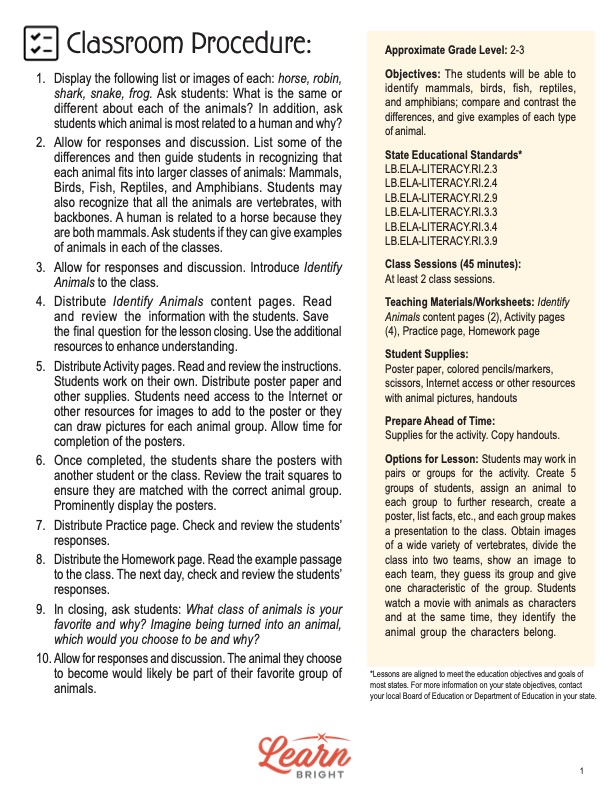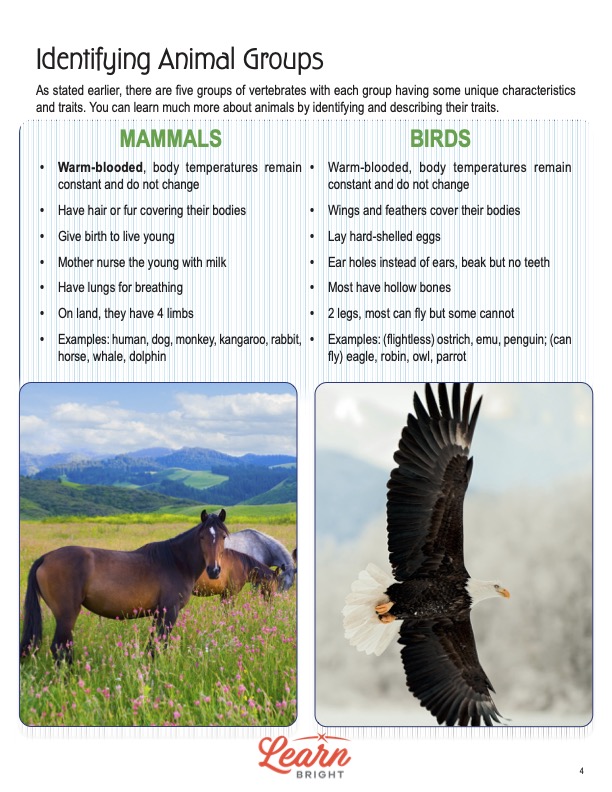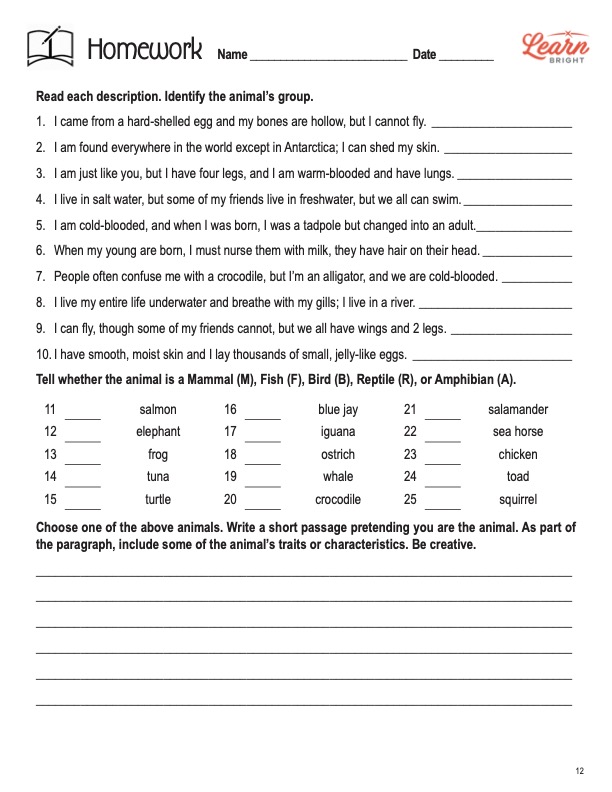Description
What our Identify Animals lesson plan includes
Lesson Objectives and Overview: Identify Animals teaches students how to recognize the traits of different vertebrates: mammals, birds, fish, reptiles, and amphibians. Students will learn about these traits and how they help people determine which group an animal belongs to. They will compare and contrast different creatures and be able to provide examples of each type. The lesson is for students in 2nd grade and 3rd grade.
Classroom Procedure
Every lesson plan provides you with a classroom procedure page that outlines a step-by-step guide to follow. You do not have to follow the guide exactly. The guide helps you organize the lesson and details when to hand out worksheets. It also lists information in the yellow box that you might find useful. You will find the lesson objectives, state standards, and number of class sessions the lesson should take to complete in this area. In addition, it describes the supplies you will need as well as what and how you need to prepare beforehand. You will only need a few items for this lesson: poster paper, colored pencils or markers, and scissors. You should also gather resources that contain pictures of animals or ensure you have internet access.
Options for Lesson
You will find several ideas for additional activities or alternatives for the lesson in the “Options for Lesson” section of the classroom procedure page. One suggestion is to create five groups of students and assign each group a specific animal to research. The groups will create a presentation about that animal to present to the class. Another idea is to find images of a variety of vertebrate animals, divide the class into two teams, and then show an image to each team and have them guess which class it belongs to. You could also watch a movie with animals as characters and have students identify the animals. For each animal, they will name the class it belongs to and list a trait or two of that animal.
Teacher Notes
The lesson provides an extra paragraph of guidance or instruction on the teacher notes page. It suggests using the lesson in conjunction with others that have to do with different animal classes. There are several blank lines that you can use to write any additional notes or extra ideas for the lesson.
IDENTIFY ANIMALS LESSON PLAN CONTENT PAGES
Classifying Animals
The Identify Animals lesson plan contains a total of four content pages. Students will first learn that scientists classify animals in order to more easily keep track of them. There are so many living things in the world, most of which are either plants or animals. We divide animals into two main groups: those with backbones (vertebrates) and those without (invertebrates). Dividing animals into smaller and smaller groups is what classifying is. Scientists classify animals by grouping them together by general traits, such as whether or not they have a backbone. They can then identify and study the traits of animals to figure out which class they belong to.
This lesson focuses on identifying animals that fall into the vertebrate group. There are five distinct classes of vertebrate animals: mammals, birds, fish, reptiles, and amphibians. Students will discover that each of these five groups share similar traits, even if the species themselves differ in certain ways. They will first learn about mammals and birds.
Mammals and Birds
Students will learn which traits an animal must have to be a mammal. Mammals are warm-blooded, meaning that their body temperature remains constant despite the environment. They have fur or hair on their bodies and give birth to live young. The mother nurses the young with milk. Mammals also breathe through lungs. Land mammals have four limbs. Examples of mammals include horses, dogs, monkeys, kangaroos, rabbits, whales, and dolphins.
Birds are also warm-blooded. They can regulate their body temperatures as well. They have wings and feathers on their bodies. Instead of giving birth to live young, they lay hard-shelled eggs. Birds have ear holes rather than ears and a beak with no teeth. Most birds’ bones are hollow. Birds have two legs, and most can fly, but not all of them. Flightless birds include ostriches, penguins, and emus. Examples of birds that can fly include eagles, robins, parrots, and owls.
Fish and Amphibians
Students will next learn to identify animals in the fish and amphibian classes. Fish are cold-blooded, which means that their body temperatures change with the environment. Fish live their entire lives underwater, and most of them—but not all—have scales that cover their bodies. They swim with fins and breathe through gill slits in the side of their bodies. When they give birth, they lay millions of soft, tiny eggs. Freshwater fish live in rivers, lakes, and streams, and saltwater fish live in the oceans and salty lakes. Examples of freshwater fish include salmon, trout, and bass. Saltwater fish include tuna, cod, sharks, and seahorses.
Like fish, amphibians are cold-blooded and cannot control their body temperatures. They have smooth, moist skin and live both on land and in the water. They lay thousands of small, jelly-like eggs. Many of those eggs hatch in the water and begin life as tadpoles. They first breathe with gills and then form lungs. Students will discover that amphibians also go through the process of metamorphosis, meaning that they change in different stages of their lives. Examples of amphibians include frogs, toads, newts, and salamanders.
Reptiles
Finally, students will learn about reptiles. Like both fish and amphibians, reptiles are cold-blooded animals whose body temperature changes with the environment. They have dry skin with scales, and many molt (or shed) their skin from time to time. Reptiles usually lay rubbery eggs, and they also have ear holes instead of ears. They have lungs to breathe and either four legs or no legs at all. They live in oceans or on land on all continents apart from Antarctica. Examples of reptiles include snakes, turtles, lizards, crocodiles, alligators, iguanas, and chameleons.
Key Terms
Here is a list of the vocabulary words students will learn in the Identify Animals lesson plan:
- Invertebrates: the animals that have no backbone
- Vertebrates: the animals that have a backbone
- Classification: the process of dividing animals into different groups according to their traits
- Traits: the characteristics that something has
- Warm-blooded: the term to describe animals that can regulate their body temperatures, meaning it remains constant despite environment
- Cold-blooded: the term to describe animals that cannot regulate their body temperatures, meaning it varies with the environment
- Metamorphosis: the process of changing from stage to stage as live progresses (e.g., a frog starts out as a tadpole and eventually becomes a frog)
- Molt: the process of shedding a layer of skin
IDENTIFY ANIMALS LESSON PLAN WORKSHEETS
The Identify Animals lesson plan includes three worksheets. These worksheets are all different and will help students reinforce their comprehension of the material in different ways. there are answer keys at the end of the document for all three worksheets. The activity worksheet answer key lists the labels with the correct traits below each one. The answer key for the practice worksheet provides the correct answers in red text. Similarly, the homework answer key has correct answers in red. For the last section, answers will vary, so the answer key provides a sample paragraph. If you choose to administer the lesson pages to your students via PDF, you will need to save a new file that omits these pages. Otherwise, you can simply print out the applicable pages and keep these as reference for yourself when grading assignments.
MATCH THE TRAITS ACTIVITY WORKSHEET
Students can work alone, with a partner, or in groups for the activity. On a poster or piece of construction paper, they will create five labels for each type of vertebrate animal. They will cut out 33 squares that describe a specific trait and glue the squares under the appropriate label. They can then add pictures of animals that represent each group.
DEFINE AND REVIEW PRACTICE WORKSHEET
The practice worksheet requires students to first match eight terms to the correct definition. They can use the content pages if they need help. They will then look at six pictures of different animals and determine which group they belong to.
IDENTIFY ANIMALS HOMEWORK ASSIGNMENT
There are a few sections on the homework assignment. The first part requires students to read 10 descriptions and determine which animal group they describe. For the next section, students will look at a list of 15 animals and decide whether they are a mammal (M), fish (F), bird (B), reptile (R), or amphibian (A). Finally, they will choose an animal from the list and write a short passage from the perspective of that animal.










